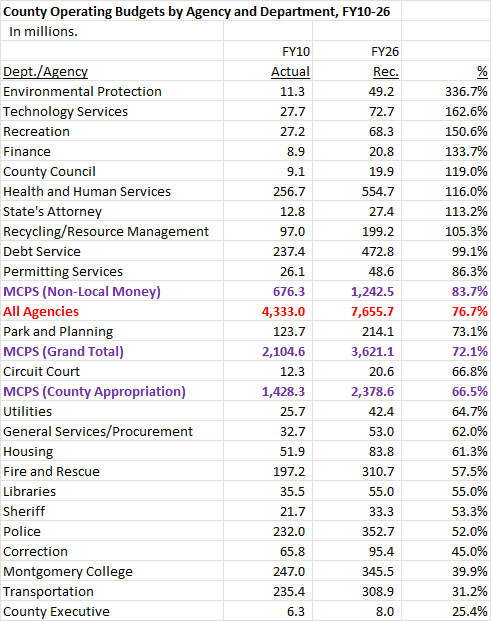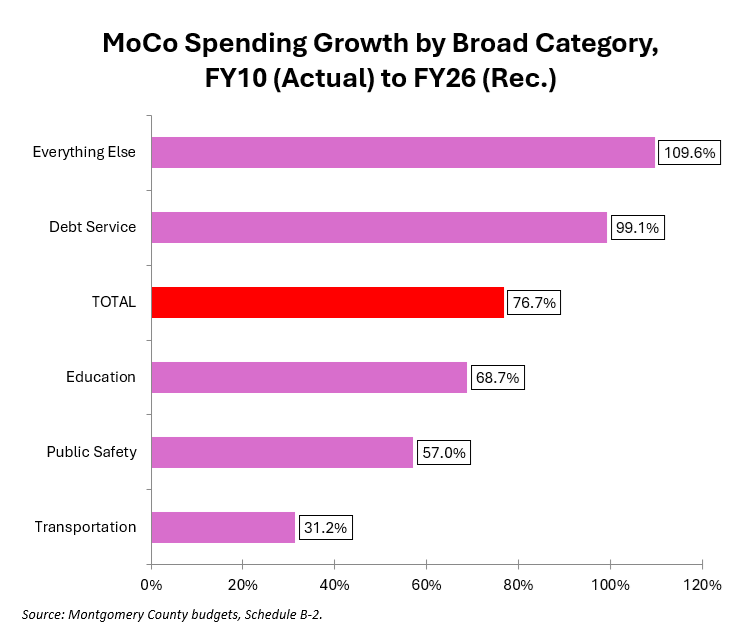By Adam Pagnucco.
In Part One, we looked at the one-year increase for the county’s major departments and agencies in County Executive Marc Elrich’s FY26 recommended operating budget. In Part Two, we looked at increases from FY19 through FY26. Now let’s look at those increases between FY10 and FY26.
Fiscal Year 2010 was a terrible year. The Great Recession was starting to take hold. Total county revenues fell by 1.2%, and without intergovernmental aid, they would have fallen by 3.7%. The county had begun to run afoul of the state’s Maintenance of Effort law, requiring a legislative bailout by the General Assembly. (It is extremely rare for Annapolis to bail out Rockville; normally that process works in reverse.) Next year would be even worse, an epic story I told in Ike Leggett’s Greatest Achievement.
Growth in the county budget since FY10 has been a long-term endeavor involving two county executives, 24 county council members and countless managers, budget staffers and analysts. The table below shows the growth rates for major departments and agencies since then.

A few notes.
Growth in environmental protection has been driven by large increases in the water quality protection charge, which former Governor Larry Hogan once branded a “rain tax.” That charge is outside the charter limit on property taxes and is a convenient way to pay for spending.
Debt service grew rapidly in the immediate aftermath of the Great Recession as the county took advantage of rock-bottom interest rates to borrow lots of money for its capital budget. Leggett, near the end of his tenure, began to bend the curve on bond issuances – a policy continued by Elrich.
MCPS had problems in the first few years of this period as the county was determined to hold the line on Maintenance of Effort. However, as I noted in Part One, MCPS has caught up a lot in the past few years. If the council adopts Elrich’s recommendation for MCPS this year, its three-year increase will be its largest in decades.
Now let’s summarize the above table in five broad categories. Education is MCPS and Montgomery College. Transportation is the county’s parking districts, Ride On and the transportation department’s operating budget. Public safety is animal services, consumer protection, correction, emergency management, fire and rescue, police, sheriff and state’s attorney. Debt service is used to pay off the county’s bonds, which are used for the capital budget. And everything else is, well… everything else. The table below shows growth in those categories.

Transportation and public safety are the laggards. The fastest growth has been in debt service (which was front-loaded in the early years and is no longer rising quickly) and in “everything else.”
Let’s think about “everything else.” Many years ago, one of my sources told me this: “Nothing is in the budget by accident. Every single thing is in there because somebody wanted it there.” And once it gets in there, it usually stays. Our budget contains items deposited by generations of now-departed politicians, whose spawn long outlasts them. And what starts as an office with two positions in it eventually grows to dozens of positions, each getting salary and benefit increases far outpacing inflation.
There was once an effort to look at savings from restructuring county government. It was the brainchild of former Council Member Roger Berliner during the dark days of the Great Recession. His 2010 council resolution created one of the more unfortunate acronyms in county government: the Organizational Reform Commission (ORC). The ORC was a jointly appointed taskforce with an equal number of picks by the county executive and the council. There have been more taskforces in MoCo than felons in the Trump administration, but the ORC had a twist: its recommendations had to be presented as bills to the council. If council members disliked them, they had to vote them down.
The 75-page ORC report of January 2011 is interesting reading. In the eyes of the county establishment, it contained more heresies than the Satanic Bible. Among other things, the predations of the ORC horde included:
Abolish the offices of the Commission for Women, the Human Rights Commission and the Criminal Justice Coordinating Commission.
Replace costly outside legal counsel with more in-house work.
Merge many of the Parks Department’s functions into the Recreation Department.
Merge the Parks Police with MCPD.
Consolidate agency procurement offices into one office.
Consolidate agency real estate offices into one office.
Consolidate the agencies’ major IT platforms.
Allow the council to approve MCPS collective bargaining agreements.
Plus more!
In the end, the ORCs were mostly defeated along with other minions seeking Mordor-style cost controls. Of six ORC bills, the council passed just one: a bill eliminating effects bargaining for the police union, which generated a ballot question war in 2012. (The county won.) And despite Elrich’s now-broken promises, there have been no efforts to restructure county government since.
Hence the growth in “everything else.”
At least the county has now turned its attention to improving MCPS. Newish Superintendent Thomas Taylor has made an audacious budget ask which he may well get. That’s the good news; the bad news is that he will then be expected to use the money productively. We shall see.
As for all of this spending, is it supportable by the county’s underperforming economy? We will examine that question in the future.
